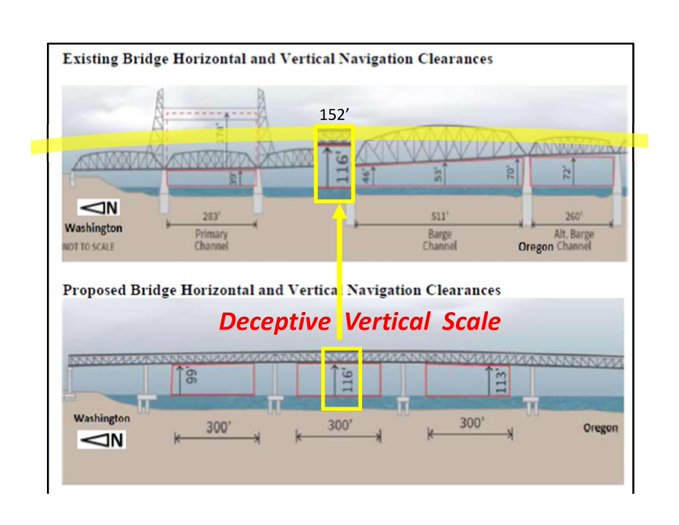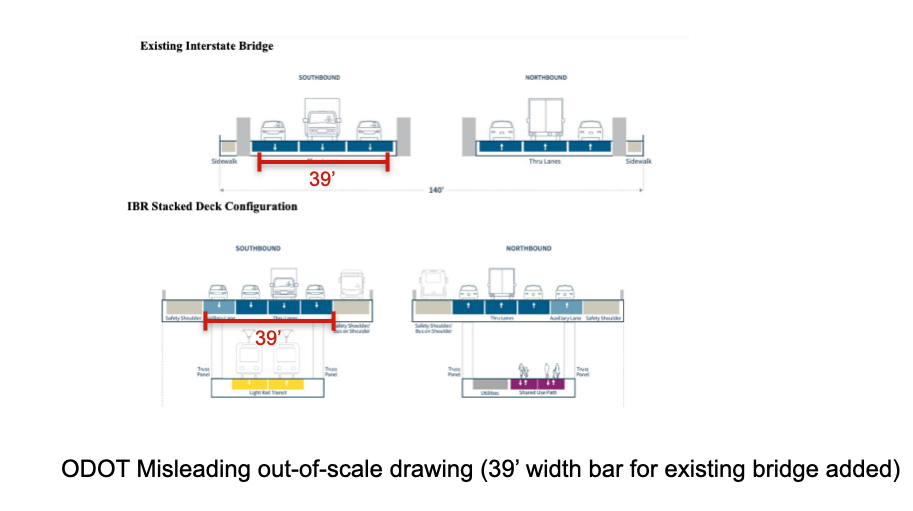The Oregon Department of Transportation (ODOT) can’t tell the truth about the width of proposed $7.5 billion Interstate Bridge Replacement Project
ODOT is more than doubling the width of the bridge from its existing 77 feet to 164 feet.
The agency can’t even admit these simple facts, and instead produces intentionally misleading and out of scale drawings to make their proposed bridge look smaller.
If engineers can’t answer a simple question about how wide a structure they’ll build, why should anyone have any confidence in their ability to accurately estimate costs or revenues?
Why is the width of this bridge, and its actual appearance a state secret?
It’s a simple question, really: How wide is the $7.5 billion”Interstate Bridge Replacement” that Oregon DOT is trying to sell the Oregon Legislature? Several members of the Joint Transportation Committee put that very question to ODOT leaders, and simply got a gibberish non-answer.
Oregon DOT’s lobbyist, Lindsay Baker wrote a rambling response to the question, which alternately, offered a long digression on the history of the existing bridges, answered a question the legislators didn’t ask (combined the over-water space covered by the bridges, including the space between the bridges), and offered absurd and meaningless statistics (28 percent of structure area would be “dedicated” to transit.). Baker’s response even included a couple of diagrams—which as we will see were purposely altered to conceal the actual width of the proposed bridge, and make it look smaller. Instead, the chief ODOT talking point is that they are merely adding “one auxiliary lane” in each direction to the existing bridge footprint.
Nothing in Baker’s non-response reveals the actual measurements of either the existing or proposed structures. Let’s cut to the chase, because these are, ODOT obfuscation notwithstanding, simple facts (the kind the real engineers actually excel at). The existing bridges have a combined roadway about 77 feet wide. The proposed bridges would have a roadway that is 164 feet wide. ODOT proposes to more than double the width of the roadway across the river. The existing bridges carry six lanes of traffic (three lanes in each direction). The proposed structure is easily wide enough to carry twelve lanes—six in each direction.
Old Bridge: 77 Feet Wide; New Bridge 164 Feet Wide
How do we know this? It takes a combination a two-second Internet search (the existing bridge) and a public records request and some algebra (the proposed bridge). First, for the record, the existing bridges have roadway widths of 38 feet and 39 feet respectively., for a total roadway width of 77 feet.
It’s harder—much harder—to find the width of the structure ODOT is proposing. In describing the width of the “locally preferred alternative” at the time it was approved by local governments, ODOT declined to say how wide the actual structure was, instead it cryptically reported that the LPA will be 16 feet narrower than the Columbia River Crossing proposed a decade ago.
So, in order to know the width of the IBR, you have to know the width of the CRC. And, the width of the CRC is effectively a state secret. In its environment impact statement of 2011, ODOT erased all the actual measurements showing how wide that bridge would be—it took a public records request to get them to disclose that it would be 180 feet wide. Here’s an excerpt of the plans we obtained via public records request, showing the CRC had a minimum width of roadway of more than 90 feet on the top decks of each of its two spans (other portions of the bridge are even wider, to accommodate a horizontal curve, as the bridge crosses the river).
So the answer to the ODOT bridge width riddle is that the LPA is 164 feet wide: 180 feet (the width of the CRC) minus 16 feet equals 164 feet. For the record, ODOT is planning two side-by-side, double-decker bridges with 82 foot top decks and 48 foot bottom decks. That creates 164 feet of roadway on the top-deck of the two bridges. In addition, there’s even more space on the bottom deck of these double decker bridges; the bottom decks are about 47 and a half feet wide, meaning that there’s a total of 95 feet of additional travel capacity on the two bottom decks. ODOT’s plan is for the highway to be carried on the top decks of the two bridges, and for light rail to be located on the bottom deck of one bridge, and a bike/pedestrian path on the bottom deck of the second bridge.
Intentionally Misleading Images
In her letter Joint Transportation Committee, ODOT lobbyist Lindsay Baker waxed poetic about the width of the existing bridges, and included a couple of extremely misleading and not-to-scale drawings of the existing bridge and their proposed alternatives. We’ll focus on the double-decker bridge alternative which ODOT has characterized as the official “Locally Preferred Alternative” (LPA). Keep in mind, the Interstate Bridge Program has spent tens of millions of dollars on engineering; its predecessor spent $200 million on the nearly identical Columbia River Crossing, and when asked to provide a drawing, ODOT offers up some “not-to-scale” cartoons to answer a simple quantitative question.
Here are the illustrations Baker provided. Above is the existing bridge, below is the proposed bridge
We’ve added one small annotation—a red bar showing the width of the wider of the two current bridges (39 feet). We’ve copied that 39 foot measuring stick to ODOT’s drawing. It seems to show that ODOT is squeezing four lanes of traffic into the same space as the current bridges three lanes. But of course that isn’t true: ODOT has rendered the two bridge images at different scales. The first clue is that the cars and trucks in the lower, IBR drawing are much smaller than the cars and trucks in the upper (existing) drawing). We printed out and measured their diagrams. The top diagram is drawn at a scale of about 1:250 (about one inch equals 20 feet). The bottom diagram is diagram is drawn at a scale of about 1:375 (one inch equals about 30 feet). The scales are chosen explicitly to make the new bridge seem smaller than it really is.
We’ve corrected ODOT’s drawing by re-projecting their image at a comparable scale. (This makes the trucks and cars roughly the same size in both drawings). With this correction it’s now apparent that the ODOT plan is to more than double the width of the current roadway, from a combined 77 feet between the two existing bridges, to a total of 164 feet between the two proposed bridges.
More than Doubling the width of the I-5 highway bridges—Enough for a 12 full lanes
We know, that at a minimum, ODOT’s plan is to increase the roadway width across the Columbia River from 77 feet to 164 feet–more than doubling the width of the roadway. The new bridge is 164 feet wide. How wide is that exactly: well, its almost exactly as wide as a football field (160 feet).
A 164 foot wide roadway can easily accommodate 12 travel lanes. Standard travel lanes are 12 feet wide. Twelve twelve foot travel lanes would occupy 144 feet of the 164 feet of roadway that ODOT proposes for its bridge structure—leaving 20 feet for shoulders. It is not uncommon on urban roadways, especially on bridges, to accommodate shoulders in this area: ODOT’s plan would allow for 4 foot inside (left) shoulders) on each crossing and 8 foot outside (right) shoulders. For reference, as part of its $1.45 billion I-5 Rose Quarter project, ODOT is proposing 11 foot travel lanes and shoulders of between 3 and 6.5 feet on a viaduct section of the project near I-84. There’s nothing illegal, unusual, or substandard about 11 foot lanes and somewhat narrower shoulders on urban roadways: In fact, the Federal Highway Administration prominently praised ODOT for narrow lanes and narrow shoulders on Portland’s I-84 Interstate Freeway. Here is a page of the USDOT report, “USE OF NARROW LANES AND NARROW SHOULDERS ON FREEWAYS: A Primer on Experiences, Current Practice, and Implementation Considerations.” FHWA HOP-16-060. The narrow shoulders on I-84 are also featured on the cover of the document.
IBR: A Pattern of mIsleading, “not to scale” drawings.
Lying with pictures is nothing new for the IBR project. As we’ve noted before, despite spending tens of millions of dollars on planning, and more than $1.5 million to build an extremely detailed “digital twin” of the proposed bridge, IBR has never released any renderings showing what the bridge and its mile long approaches will look like to human beings standing on the ground in Vancouver or on Hayden Island. And the IBR also released similar misleading and not-to-scale drawings that intentionally made the height and navigation clearance of their proposed bridge look smaller than it actually is.

Hiding the actual width of the bridge they intend to build is a scene-for-scene remake of false claim made for the preceding project—the failed Columbia River Crossing (CRC). In 2010, in response to objections from the City of Portland and Metro, ODOT and WSDOT announced they were reducing the size of the CRC bridge from 12 lanes to 10 lanes. But in reality, all they did was change the references in the project documents to that number of lanes, while literally erasing from the Final Environmental Impact Statement every single reference to the actual widths of the bridges and other structures they intended to build. A public records request showed the actual plans for the bridges — which were not published — were exactly the same size (180 feet in width) as they were for the 12-lane version of the bridge.
ODOT seems to be congenitally incapable of revealing the actual width of any of the major projects it is proposing. As we’ve pointed out at City Observatory, it has gone to great lengths to conceal the width of the proposed I-5 Rose Quarter project, which as it crosses under the Broadway and Weidler interchanges in Portland will be 160 feet wide. While the project’s Environmental Assessment pretended the project was 126 feet wide (again, based on cartoon “not to scale” images), secret ODOT documents confirmed that the agency has always been planning a 160-wide roadway.
Reference
Here’s the full letter from ODOT’s Lindsay Baker to the Oregon Legislature’s Joint Transportation Committee.
https://olis.oregonlegislature.gov/liz/2023R1/Downloads/CommitteeMeetingDocument/271285





